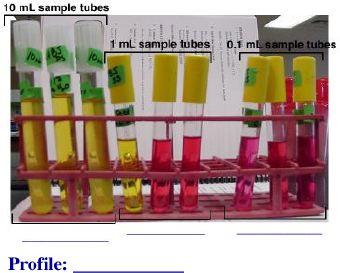Lecture 23: Water Microbiology

I. Introduction
A. Water microbiology is the ________________________________________________ ______________________________. This is done to determine what organisms are present, and if they are helpful or harmful.
B. The safety of water for drink and contact is the main reason for ______________ _____________________________________________. We must know if the water will cause harm to us or the environment. Some microorganisms can actually reduce the amount of environmental damage. We treat drinking water to make it potable.
II. Harmful organisms (Bacteria, Parasites and Viruses)
A. _____________________________________________________________________ may affect as few as 1 or 2 people, or they may affect enough people to reach epidemic proportions. Luckily, the Safe Water Drinking Act and the _____________________ ______________ help keep us safe. Water Treatment is not without flaws, so it is still a ___________ _______________ that drinking water is safe, especially with the increased number of HIV/AIDS patients.
B. Water contamination from ________________________________________________ __________________ introduces into the water:
1. Pathogenic Bacteria (Mostly enteric or GI Tract)
a. Vibrio cholerae which causes Cholera
b. ____________________ including Salmonella typhi
c. Cyanobacteria which may be a risk factor in cancer
d. Mycobacterium
2. _____________________ including the “Super Bugs” Cryptosporidium and Giardia
3. Viruses including Hepatitis viruses
III. Screening for pathogens
A. It is ___________________________________ to screen for enteric pathogens (e.g. Shigella and __________________________) for several reasons:
1. These pathogens enter the water supply _______________________ because not everyone is infected and shedding them continuously.
2. Most enteric pathogens are not stable in the environment, therefore they __________________________________________________________.
3. These pathogens are generally ________________________________ so they may ________________________________.
4. _______________________________________ are required to culture enteric pathogens.
B. Due to these problems associated with finding pathogens in large volumes of water, we will instead look for______________________________________________ whose presence indicates fecal contamination. The most common group of these indicator organisms are called ___________________________.
C. Coliforms are ______________________________________ that are present in the ___________________________ of every warm blooded animal. They are defined as aerobic or facultative anaerobic Gram-negative rods that do not form spores, but do ________________________________________________________________________. The _________________________________________________________________ than enteric pathogens for several reasons:
1. Animals and humans ________________________________________ in their GI tract.
2. They are ____________________________ in feces.
3. Their presence in water will indicate fecal contamination which suggests the possibility of pathogen contamination.
4. Coliforms _______________________________ in water and are much _______________________________ in the lab.
D. The detection of coliforms is complicated by the fact that____________________ ________________________________________________. In fact, some are commonly found in the environment. Because of this, we commonly distinguish coliforms biochemically, to determine ____________________________________ using the ___________________________________________.

IV. We will screen waste water treatment plant (WWTP) influent and effluent, Laramie River water, water treatment plant (WTP) influent and effluent and drinking water for the presence of coliforms.

*_________________ are one main reason for ___________________________ ____________________ of water.

V. There are several tests that we will use to determine whether fecal coliforms are present in a water sample.
A. The ________________________________________ is used to quickly examine for the presence of coliforms. This test is able to detect ____________________________ _________________________________________.
B. The PA broth contains ___________________ and a pH indicator which will change from a purple color to a ______________________________________________ from the fermentation of lactose.

C. The __________________________________ is a test that may be used to assay a __________________________________________ and allow us to _________________ ______________________ the number of coliforms in that sample.
1. The water is passed through a 0.45 micron ______________.
2. The filter is then placed on a selective and differential medium, usually EMB or Endo agar, which allows for identification of coliforms.
3. Once colonies form, they can be counted to determine the number of coliforms present in a sample.

D. The Multiple Tube Fermentation Method is a test that is performed in three stages.
1. _______________________________ uses a _____________________ ____________________ that will be used to determine the presence of lactose fermenting bacteria in the sample. The nine inoculated lactose broth tubes will also enable us to _____________________________________ the amount of coliforms present in our sample by using the MPN (most probable number) table located in your lab manual.

How many coliforms/100 mL are present in this sample?
2. _________________________________ involves the inoculation of ________________________ with a lactose positive sample. EMB selects for the growth of ______________________________ organisms and differentiates bacteria based on their ability to ferment lactose.
3. _____________________________ is done by selecting a lac+ colony from our EMB plate and _______________________________________ ___________________________ to verify lactose fermentation. Also, __________________________ should be inoculated with the same colony to demonstrate the Gram-negative, _______________________________ character.
E. These tests are done on numerous bodies and sources of water ______________ ________________________________________________.
VI. Other microbiology applications in water treatment
A. Biosensing is one of the new breakthroughs in microbiology. Korean scientists are using ____________________ containing the lux operon to indicate if there has been a failure in waste water treatment.
B. Britain has the Microtox System which uses Photobacterium directly to detect pollutants. They can’t ________________________________________.
C. Pseudomonas expressing ______________ and other genes encoding toluene or benzene recognition will fluoresce in presence of these pollutants.
|






